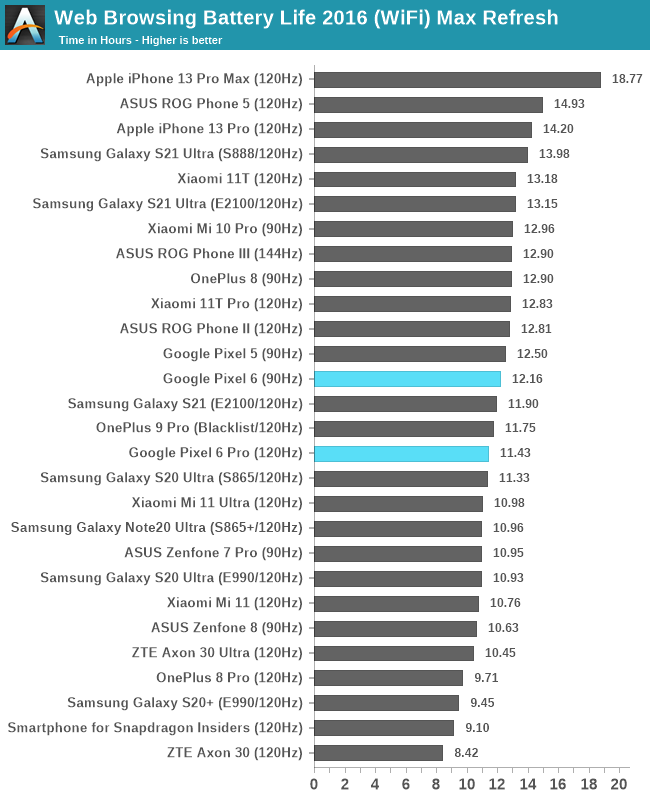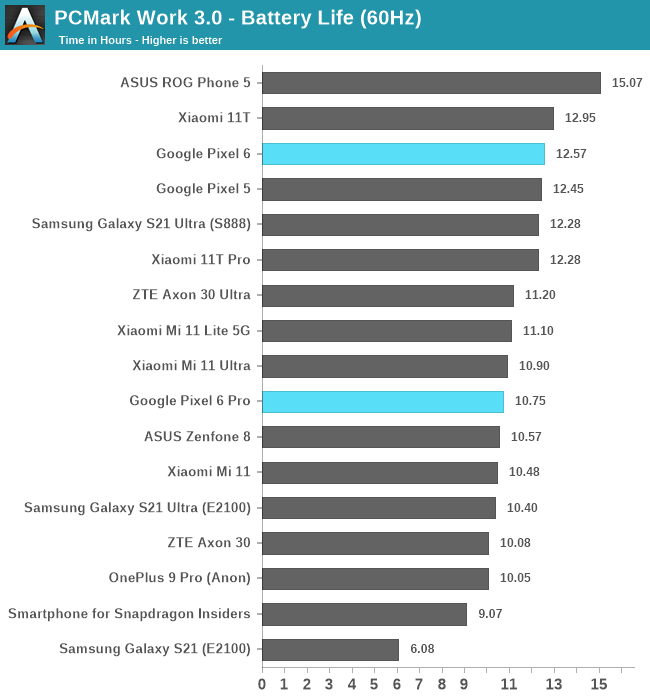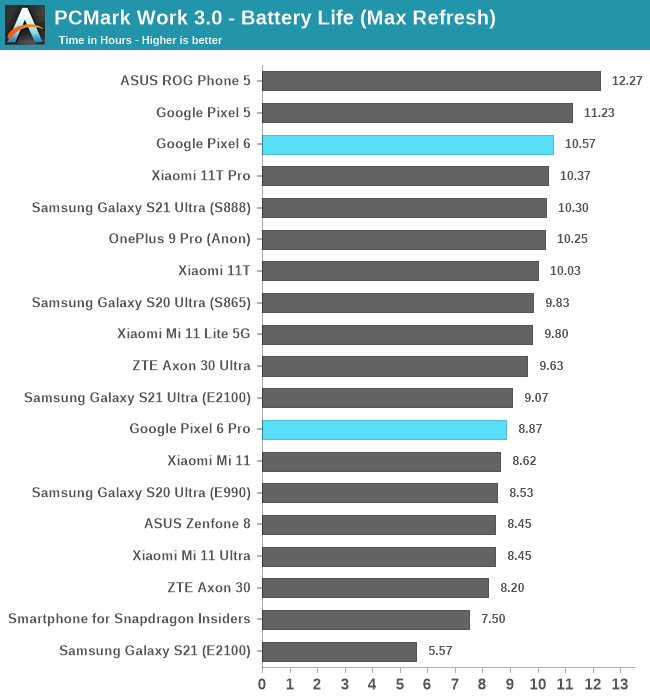Google's Tensor inside of Pixel 6, Pixel 6 Pro: A Look into Performance & Efficiency
by Andrei Frumusanu on November 2, 2021 8:00 AM EST- Posted in
- Mobile
- Smartphones
- SoCs
- Pixel 6
- Pixel 6 Pro
- Google Tensor
Phone Efficiency & Battery Life
While not directly released to the Google Tensor, I also finished running the various battery tests for the Pixel 6 and Pixel 6 Pro, and there are some remarks to be made in regards to the power efficiency of the devices, and how the new SoC ends up in relation to the competition.
As a reminder, the Pixel 6 comes with a 4614mAh battery and a 6.4” 1080p 90Hz OLED screen, while the Pixel 6 Pro features a 5003mAh battery and a 6.71” 1440p 120Hz OLED display, with variable refresh rate from 10-120Hz.

Starting off with the 60Hz web browsing results, both Pixel phones end up extremely similar in their longevity, at 14 hours runtime. The regular Pixel 6 is hard to compare things to as we don’t have too many recent phones with 90Hz displays in our results set, however the Pixel 6 Pro should be a direct comparison point to the S21 Ultras, as both feature 5000mAh batteries and similar display characteristics. The P6Pro here ends up slightly ahead of the Exynos 2100 S21 Ultra, which might not be too surprising given that the Tensor chip does end up at somewhat lower CPU power levels, even if performance is lower. It’s still quite behind the Snapdragon 888 variant of the S21 Ultra – which is again quite representative of the SoC efficiency differences.

Running the phones at their respective max refresh rates, both devices see larger drops, however the Pixel 6 Pro especially sees a more substantial hit. This time around, the 6 Pro ends up significantly behind the Exynos 2100 S21 Ultra, which had only a minor drop in the 60 -> 120Hz results.

Shifting over to PCMark at 60Hz, we see that there’s a larger difference in favour of the Pixel 6, as the Pixel 6 Pro ends up behind it in longevity by almost two hours. The 6 Pro still ends up in line with the E2100 S21U, however that device showcases significantly higher performance numbers in the test, which acts both as a performance metric for device responsivity as well as a battery life test.

At 120Hz, the 6 Pro ends up worse than the E2100 S21U, and quite worse than the S888 S21U.
When I was investigating the phones, the 6 Pro’s power behaviour was quite weird to me, as I saw best-case baseline power figures of around 640mW, and sometimes this inexplicably would also end up at 774mW or even higher. What this reminded me of, was the power behaviour of the OnePlus 9 Pro, which also suffered from extremely high baseline power figures. Both the 6 Pro and the 9 Pro advertise themselves as having LPTO OLED panels, but both of them very clearly do not behave the same as what we’ve seen on the Note20Ultra or the S21Ultra phones. The 6 Pro also only goes up to up to 750 nits 100% APL peak brightness in auto-brightness mode under bright ambient light, which is significantly lower than the S21U’s 942 nits. I think what’s happening here is that the Pixel 6 Pro simply doesn’t have the most state-of-the-art display, and thus is quite less efficient as what we find on the competition. It does kind of make sense for the price-point of the phone, but also explains some of the battery behaviour.
Naturally, the Tensor SoC also just doesn’t appear to be as efficient. Particularly many UI workloads would be run on the A76 cores of the chip, which just outright have a 30% perf/W disadvantage. The phone ends up OK in terms of absolute battery life, however performance metrics are lower than other devices.
I think the regular Pixel 6 here is just a much better device as it doesn’t seem to have any particular issues in display efficiency, even if it’s just a 1080 90Hz panel. There are naturally experience compromises, but it’s also a $599 phone, so the value here is very good.
US readers who are used to Qualcomm phones might also encounter efficiency regressions when under cellular data – we abandoned doing testing here many years ago due to the impossible task to get consistent test environments.










108 Comments
View All Comments
anonym - Sunday, November 7, 2021 - link
I don't have any data but A76 is more efficient than A78 while relatively lower performance region. According to following DVFS carves, A77 is out of the question.https://images.anandtech.com/doci/15813/A78-X1-cro...
boozed - Tuesday, November 2, 2021 - link
So do we call this design "semi-custom" or "very-slightly-custom"?watzupken - Wednesday, November 3, 2021 - link
I think we have come to a point that pushing performance for mobile devices is starting to slow down big time, or in some cases like Exynos where we see regressions. The SOC gets refreshed each year, pushing for higher performance. The fabs however is slower to catch up, and despite the marketing of 7nm, 5nm, 3nm, etc, they may not be anywhere near what is being marketed. In this case, squeezing a fat GPU sounds great on paper, but in real life, the sustained performance is not going to make a huge difference because of the power and heat. In any case, I feel the push for an annual SOC upgrade should slow down because I certainly don't see significant difference in real life performance. We generally only know that last years SOCs are slower only when running benchmarks. Even in games, last gen high end SOCs can still handle challenging titles. Instead, they should focus on making the SOCs more power efficient.damianrobertjones - Wednesday, November 3, 2021 - link
All I want is for all phones to be able to record the front and rear camera at the same time. VLog fun. Such a simple thing... .Whiteknight2020 - Wednesday, November 3, 2021 - link
Not India, China, UK, Russia, most of the EU, Africa. Which is the vast majority of the world's population and the vast majority of the world's phones, a great many of which are still feature phones.Whiteknight2020 - Wednesday, November 3, 2021 - link
Not India, China, UK, Russia, most of the EU, Africa. Which is the vast majority of the world's population and the vast majority of the world's phones, a great many of which are still feature phones.eastcoast_pete - Wednesday, November 3, 2021 - link
To me, one of the most interesting points about this "meh" first Google custom SoC is that it was created with lots of Lego blocks from Samsung; I guess Google working with Qualcomm was either out of the question or not something either was willing to do. Maybe this was about Google wanting to show QC that they can develop a Pixel smartphone without them, maybe the two compete too closely on ML/AI, or maybe they just don't like each other much right now - who knows? Still, an SD 888-derived SoC with Google TPU would have likely been better on performance and efficiency. This one here is an odd duck. As for the Pixel 6, especially the Pro: camera is supposed to be spectacular, but with the battery life as it is and, of course (Google, after all), no expandable storage and no 3.5 mm headphone connectors, it missed the mark for me. But, the Pixels are sold out, so why would Google change?Whiteknight2020 - Wednesday, November 3, 2021 - link
If you want a "really excellent camera", sorry to disappoint you but you'll need to be buying an actual camera. The only thing a multipurpose portable computing device can ever be excellent at is being a multipurpose portable computing device.FunBunny2 - Wednesday, November 3, 2021 - link
"a multipurpose portable computing device."isn't that pretty much verbatim what Stevie said when he showed the original iPhone? nothing has really changed since. it was, kinda, a big deal when Stevie intoned that the thingee incorporated 3, count em 3!, devices that you had to carry that day!!! internet, phone, and number 3 (whatever that was). is a 2021 smartphone really anything more?? I mean, beyond the capacity of more transistors. thank ASML (and some really smart physicists and engineers) for that not Apple or Samsung or Google or ... last time I checked Apple's 'our own ARM' SoC is just bigger and wider ARM ISA, due to the, so far, increasing transistor budget available at the foundries.
that all begs the fundamental question: if Apple and The Seven Dwarfs have access to the same physical capital (ASML, et al) why the difference? if everybody spends time and money tweaking a function (that they all need, one way or another), in some time (short, I'll assert) The One Best Way emerges. the task, in the final analysis, is just maths. of course, Best is not a point estimate, as many comments make clear; there're trade offs all along the line.
it would be fun to use one of the Damn Gummint's supercomputers (weather or nucular bomb design) to spec a SoC. wonder how different the result would be?
NaturalViolence - Wednesday, November 3, 2021 - link
The math for the memory bandwidth doesn't check out. From the article:"4x 16-bit CH
@ 3200MHz LPDDR5 / 51.2GB/s"
But 3200MHz x 64 bit is 25.6GB/s, not 51.2GB/s. So which is it?